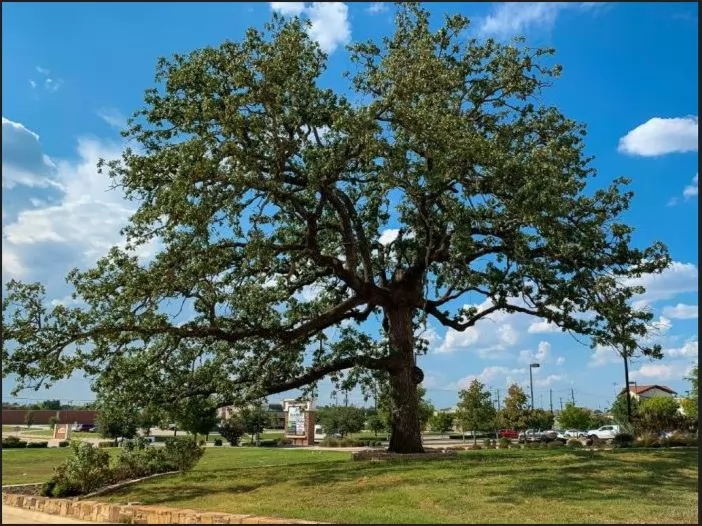Article by Diane Wetherbee, Citizen Forester Liaison
Cross Timbers Road. Cross Timbers Development District. Cross Timbers Gazette. It seems everywhere you turn in North Texas, you see the words “Cross Timbers.” Newcomers to the area may wonder what the Cross Timbers is and why it’s so important that it is immortalized in names all over the area.
The Cross Timbers Forest is the last of the forests early European settlers encountered as they traveled from the east to the west. Look at any two maps, and none will agree on the exact location of the Cross Timbers. The forest isn’t a single continuous band of trees, but instead is a mosaic of forests with prairie glades throughout. It runs generally north and south, stretching from southeast Kansas, through central and eastern Oklahoma, then through north central Texas all the way to the Waco area. Post oaks and blackjack oaks are the predominant species, along with hickory, elm, and hackberry trees. The understory is a tangled mess of vines, briars, and dense shrubs, nothing like the neat pine forests of East Texas.
Plant ecologist Suzanne Tuttle, retired manager of Fort Worth Nature Center, explains that the Cross Timbers Forest is two separate bands of that ancient forest mosaic, each growing on distinctively different soil types. The Eastern Cross Timbers, which runs through much of western Denton County, including Flower Mound and Lantana, is a narrow band no more than 15 miles wide, with coarse, sandy soils over sandstone. The Western Cross Timbers, a much wider band located generally just west of Fort Worth and stretching almost to Abilene, has shallower sandy soils with a limestone base.
The Grand Prairie separates the two major forest sections, although there are many large stretches of prairie that run throughout the Cross Timbers. Long Prairie, which gives FM 2499 its street name, is one example of a very large prairie within the Eastern Cross Timbers. The Flower Mound, the 12.5-acre prairie remnant that gives the town its name, is the sole remaining tiny piece of Long Prairie.
If you’ve ever hiked off trail in the forests of North Texas, you’re well acquainted with the challenges the Cross Timbers must have presented to travelers during our country’s westward expansion: low-growing forests full of trees with gnarled limbs. blankets of thorny vines, and thick underbrush. Famous writer Washington Irving, author of The Legend of Sleepy Hollow and Rip Van Winkle, joined an expedition in 1832 to the Indian Territory (present-day Oklahoma). After weeks of hacking their way through the Cross Timbers Forest, Irving wrote, “I shall not easily forget the mortal toil, and the vexations of flesh and spirit, that we underwent occasionally, in our wanderings through the Cross Timber. It was like struggling through forests of cast iron.” And that’s how the Cross Timbers got its nickname, the Cast Iron Forest.
You must be tough to make your way through the Cross Timbers. The forest effectively cut off westward travel between the prairies to the east and the Great Plains of the wild western frontier. For those European settlers who were hardy enough to settle here, it helped protect them from raids of the Plains tribes living to the west, like the Comanches. That’s one reason you don’t hear many stories about Indian settlements or raids in Denton County. Native American tribes in this area were often nomadic, and they had to be tough to make their way through the Cross Timbers, as well.
Tuttle, the plant ecologist, warns that the relatively small size of the Eastern Cross Timbers makes it highly endangered, since so much of it is already developed. “The Eastern Cross Timbers is probably the most endangered ecosystem in Texas. It is small in acreage and is in the crosshairs of one of the most rapidly developing areas of the United States,” Tuttle said. Post oaks grow very slowly, and they often don’t look as old as they are. In untouched areas, the Cross Timbers has post oaks that are 200-400 years old, predating the birth of the U.S. Yet a 200-year-old post oak may only be 30 feet in height and not very large in circumference, and because of that, we often don’t recognize their significance.
These tough forest guardians have withstood our region’s ice storms, hail, strong winds, frequent droughts, and temperatures that range from lows near zero in winter to over 100 in summer. But by far their fiercest adversary is human expansion into the desirable North Texas area. They are sensitive to root disturbance, so building too close to the tree or running construction equipment over the root zone can cause a tree to die. Post oaks are rarely found in the nursery trade because they take so long to grow and are difficult to transplant successfully. Your best bet is to start with an acorn planted where you ultimately want the oak.
If you’d like to read more about the Cross Timbers Forest and its important role in forming our history and our current landscape, pick up a copy of Richard V. Francaviglia’s book, The Cast Iron Forest: A Natural and Cultural History of the North American Cross Timbers. It’s a fascinating story of the important part this strange, tough forest and prairie mosaic played in the settlement of North Texas, its continuing struggles for survival, and its sometimes dreary outlook for survival in the future. As Francaviglia puts it, “…despite incredible changes, the cast iron forest stubbornly refuses to disappear. Despite the passage of several centuries, the Cross Timbers still resonate with history and generate a sense of wonder.”
Appeared in The Cross Timbers Gazette, October 20, 2022

